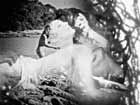:
distribution gauge :
soundtrack :
distributed by :
| Corpus |
| © 2015 35mm, b/w, 1:1,37, DolbySR, 19 min Dirk Schaefer Sixpack Film (Vienna) |

In 1925 Surrealists in Paris began to use a writing and drawing technique they called “Cadavre exquis” or “Exquisite Corpse”, whereby several participants blindly collaborated in the creation of a single unified image or sentence: One person wrote a word or drew part of a body on a piece of paper, folded it over and passed it on to the next participant who would add another element without seeing what preceded it, hand the paper over to the next person, and so on. The result was a highly synthetic sentence or picture, a composition in the original sense of the word, consisting of conjoined elements sourced from different origins.
The name of this technique was taken from one of the first sentences it produced: "Le cadavre exquis boira le vin nouveau," or "The exquisite corpse shall drink the new wine."
While I derived most of my prior films near exclusively from a single found footage source, The Exquisite Corpus is based on several different films, referencing the surrealist “exquisite corpse” technique. You’ll find rushes from commercials, an American erotic thriller from the 1980s, a British comedy from the 1960s, a Danish as well as a French porn film (both most likely from the 1970s), an Italian soft-core sex movie from 1979, and a (British?) amateur movie – it could be considered a “nudist film” since there are no explicit sex scenes but all the actors run around naked, for no immediately obvious reason.
I mainly focused on these erotic films; they are related in that each tells a completely insane story that is entirely irrelevant but achieves the main goal of showing naked human bodies. I play on this attitude by raising the body of film itself to the forefront, which thereby becomes the central theme of The Exquisite Corpus.
The Exquisite Corpus commences with a search along a seashore. We glimpse a few actors from the prow of a small boat. Eventually, the object of the search is discovered: a sleeping beauty lies on the beach, before our very eyes. Suddenly and quite unexpectedly, we are drawn into her dream. It’s a highly ambiguous dream – sensuous, humorous, gruesome, and ecstatic – a broadly defined seduction lusting for a tangible, perceptible, exquisite physicality – including the body of the film.
In addition to the aforementioned found footage, many indexical signs and images are imprinted upon the film: photograms of natural origin, like leaves and flower buds, as well as cultural products like meshes and crochet samples. These indexical signs (also known as “rayographs”, from Man Ray’s darkroom experiments) not only reveal a very specific way of shaping and sculpting analog film, they also create an organic atmosphere into which photographic, namely iconic signs (which also constantly switch between a constructed cultural interior and nature scenes) are embedded. Written words and letters pop up in midst of these pictures, referencing printed as well as hand writing – and echoing “iconic” (printed) and “indexical” (imprinted) systems.
These diverse sources serve as a basis for The Exquisite Corpus, giving rise to heterogeneities I fully embraced in the spirit of the surrealist technique of the “cadavre exquis”. At the same time, the title of the film refers to the “exquisite corpse” which analog cinema nowadays represents: an exquisite corpus stamped with an expiration date. The final date remains unknown, but it is foreseeable.
Peter Tscherkassky